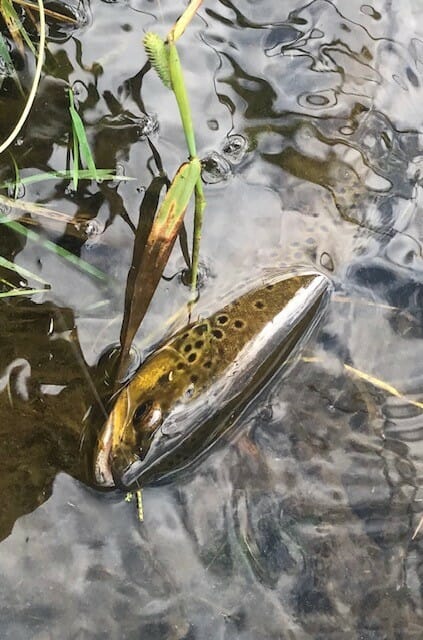By Duke Welter
On a recent morning near Viroqua, Wisc., an angler didn’t know what to expect.
Temperatures the day before had reached the upper 80s, the latest in a hot string. Overnight rains had some impact. Fields were wet and larger waters ran cloudy, but weren’t unfishable.
Heading first to one of the “forks” near Viroqua, a larger stream with lots of restoration, I fished downstream for a quarter mile with not a single sign of a fishy intelligence anywhere. Finally I took the stream temperature: 69 degrees.
The rain and overnight air hadn’t cooled it off. I pulled out and drove to another site a few miles away.
This was a smaller water, high in the watershed, less than a mile below the two springs that gave it flow.
It doesn’t get much pressure because it’s so small, way thinner than my 8-and-a-half foot rod, and right now the vegetation along the banks is reaching its peak.
My gosh, that walk downstream was a grind: milkweed and wild parsnip higher than my head, Jerusalem artichokes even higher.
Finally, I got to the bottom of the reach I planned to fish and stopped to catch my breath and tie on a fly.
The water temperature was 59 degrees. I waded wet, blissfully cool in waist-deep water.
After that slog downstream through the meadow, darned if I was going to fish back up from the bank while fighting the thick streamside foliage.
My dark beetle didn’t prompt a hit. Were they in here?
I tied on an orange beetle and had one hit but lost the fly in a tree on the hookset.
An orange hopper? Another hit, and miss, and fly lost in a tree.
Since I try only to carry a half-dozen flies per outing, this was getting serious.
Was it time for a ToeBiter? I tied on a #8, drifted it with through a bathtub-sized hole, and watched a trout come up and eye it before going back down. Another cast, this time a twitch, and the fish snatched it.
It turned out to be a 12-inch brown, with a #10 frog in its gut. A northern cricket frog, I wondered?
The ToeBiter was the ticket. I worked upstream and coaxed out another eight or nine trout — all browns, mostly in the 10-13 inch range — from behind rocks and under banks. A good hour’s work.
The last couple of fish were landed just a long cast from the car.
By the time I opened the tailgate, the temperature was 82 degrees, headed toward another high in the mid 80s.
When it’s hot and steamy it could be easier to just surrender to head-high vegetation and choose easier places to reach and fish. But what would you be missing?
Maybe some of the best fishing of the season.
Duke Welter is the outreach coordinator for Trout Unlimited’s Driftless Area Restoration Effort. He is based in Viroqua, Wisc,, in the heart of the Driftless and close to hundreds of miles of wild trout water, much of it professionally restored by TU and its partners.



